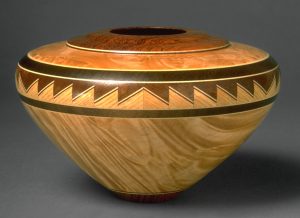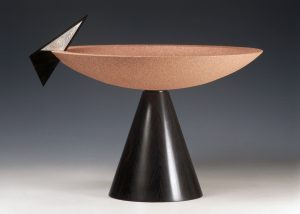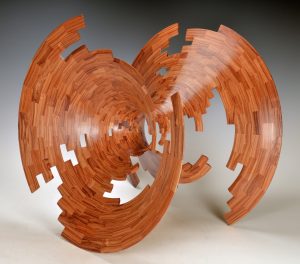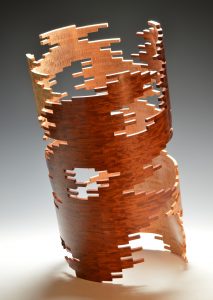Materiality of the Voids
THE DECONSTRUCTED FORMS OF BUD LATVEN
Profile by Kevin V. Wallace
BUD LATVEN has influenced countless artists and craftspeople with his approach to lathe work while following the path of a highly individual artist. He is an innovator, and the complexity of his forms might lead one to think of him foremost as a talented woodworker. Yet it is the ideas behind the pieces and the constant experimentation which really sets him apart.
Latven’s life with wood began in 1972 when he moved to Albuquerque, New Mexico and took a job at a woodshop making cabinets and furniture. Soon after, he started to create his own furniture utilizing timber burls and within two years he had opened a fully equipped studio. “I was just trying to make a living and liked the independence and creative enjoyment of the process,” Latven recalls of the time. For the next 10 years he sold his furniture at galleries and craft shows across the American Southwest.
Then everything changed in 1982 when he was commissioned to create production goblets at his studio. It wasn’t long before he made the transition from furniture maker to lathe artist creating vessel forms. He was attracted by what he saw as an “unexplored medium that was open to interpretation and experimentation”.
By working in a field that was not rigidly defined, Latven saw greater potential for artistic freedom. As the woodturning field had not yet coalesced at that time, and there were no books on the subject, he looked to Mediterranean and Native America pottery to develop a repertoire of vessel shapes and designs. “Was I trying to make art? Not really,” Latven says of these early vessels. “I just enjoyed making and selling wooden pots and wasn’t particularly concerned with personal expression.”
 In order to gain a better understanding of vessel forms, Latven travelled to Italy and Greece specifically to research Minoan and eastern Mediterranean ceramic vases. He also researched pre-Columbian and post-contact Native American ceramics and his vessels from the early and mid-1980s were rooted in these two traditions. The carved forms he creates today began as a study of the degenerative nature of the rock constructed Anasazi ruins in Chaco Canyon and Mesa Verde in the Southwestern United States.
In order to gain a better understanding of vessel forms, Latven travelled to Italy and Greece specifically to research Minoan and eastern Mediterranean ceramic vases. He also researched pre-Columbian and post-contact Native American ceramics and his vessels from the early and mid-1980s were rooted in these two traditions. The carved forms he creates today began as a study of the degenerative nature of the rock constructed Anasazi ruins in Chaco Canyon and Mesa Verde in the Southwestern United States.
In 1985, Fine Woodworking magazine put a picture of one of Latven’s Greek-inspired hydria vessels on its front cover, an event which lifted his career onto a national level. In the latter part of the 1980s he participated in numerous national art and craft exhibitions as his traditional Southwest vessel forms began to give way to more contemporary explorations. “It was during this period that I started looking deeper into issues concerning materiality, surface and form”, Latven says.
When he began exhibiting at shows on the East Coast of the US he became aware that there were others creating turned wood vessel forms, though they were initially few in number. “Most of the turning at the time was what I called ‘pure form’ turning in a Bauhaus-like minimalist style with no adornment or surface carving. At the urban coastal shows I also saw that there was a prevalent style in other craft media that was influenced by the colourful Memphis style that came out of Italy in the early 1980s. This style was developed by Etorre Sottsass, an Italian architect and designer, and included a postmodern approach to colour and adornment.”
The influence of Sottsass on a generation of distinguished American furniture makers that included Wendell Castle and Garry Knox Bennett, was apparent to Latven and, coming from a furniture background, he felt more akin to the work of these individuals than fellow wood turners.
At a show sponsored by American Craft Enterprises in San Francisco during the mid-1980s, Bennett invited Latven to visit his studio in Oakland after the show. This encounter directly influenced Latven’s conceptions of wood turning. “Bennett was an iconoclast when it came to tradition with wood, and I was curious about his approach. It was fresh and creative. This encounter led me to challenge the tradition of pure form in woodturning by questioning assumptions about shape, surface and technique,” recalls Latven. Bennett didn’t influence Latven’s actual work as much as impact his conception of art making.
 From this and other experiences in the broader craft field, the late 1980s produced an explosion of new forms that explored surface texture, colour, materiality and the concept he calls ‘vesselness’. He juxtaposed dyed, airbrushed and raw surfaces in his Connections Series and developed a series of works that had silver rods piercing the walls and rims of the forms called the Tightwire Series. He also used melted metals like aluminum, copper and silicon bronze, which he sprayed onto small vessels and tall anthropomorphic forms a technique not used anywhere in the field then or even today.
From this and other experiences in the broader craft field, the late 1980s produced an explosion of new forms that explored surface texture, colour, materiality and the concept he calls ‘vesselness’. He juxtaposed dyed, airbrushed and raw surfaces in his Connections Series and developed a series of works that had silver rods piercing the walls and rims of the forms called the Tightwire Series. He also used melted metals like aluminum, copper and silicon bronze, which he sprayed onto small vessels and tall anthropomorphic forms a technique not used anywhere in the field then or even today.
Along with these creative works, Latven also produced a series of more classic hardwood bowls and vases made of segmented and staved constructions for the gift and collector market. These works used both domestic and exotic hardwoods and he gained valuable knowledge about the broad range of properties that these hardwoods possess, such as strength, flexibility and density. This knowledge later supported his explorations into larger carved forms.
As Latven’s work changed, the marketplace did as well. As his work became more sophisticated and sculptural, he needed to focus on a market that welcomed this kind of work and find collectors with budgets to support the sort of work that required increasing amounts of time and expense to create. He found this in high-end affairs such as the Smithsonian Craft Show and the Philadelphia Craft Show sponsored by the prestigious Philadelphia Museum of Art. As the field of contemporary woodturning grew, a number of galleries also appeared on the scene and Latven was sought after to exhibit with the best of them.
By the early 1990s, he was thinking about developing a more definitive language of identifiable forms whose parameters were broad enough to allow for expanded creativity. For years he had questioned the relevance and pervasive adherence to the concept of the vessel form in general lathe work. It was then that he started to open out the bottom of his forms, many of which had become based on rotated curves and conic sections, such as parabolas and ellipses.
These forms were created out of segmented bodies with randomly placed contrasting elements and sections. “Over time, these contrasting sections became more and more prevalent in my work until I realized that the darker contrasting sections were really an attempt to created visual voids,” recalls Latven. “It was at this point that I started carving out sections, creating contrasting voids or negative spaces in my forms. The geometric shapes then became canvasses upon which to paint with wood and space.”

Many of these works are based on three-dimensional conic sections. These include the cylinder, ellipsoid, cone, paraboloid, hyperboloid and hyperbolic paraboloid. The carving in these works explores concepts of disintegration, fragmentation and re-emergence, with works in the Tower Series suggesting decaying and degenerate architecture, while those in the Impact and Torsion Series are more fluid and dynamic.
In 1999 Latven created his first bronze casting of one of the Torsion forms to assess how it translated into another medium. To accomplish this, he spent a year visiting the Shidoni Foundry in Tesuque, New Mexico, learning the process and overcoming the technical difficulties. “This experience taught me to look at my forms in a different light, not just as pedestal pieces but as maquettes for larger sculptures,” he says. “It taught me to view these objects as an active participant within and through the forms.”
Viewing Latven’s carved forms, it is difficult to pinpoint artistic influences as they have been largely philosophical. As an example, he attributes significant influence to landscape painters from the Barbizon through the Impressionists to the Moderns for their tenacity and highly creative spirit. “I was interested in how the Impressionists communicated ideas to each other and watched new artforms take life and flourish,” Latven explains. “I couldn’t help relating this to the developing contemporary craft and woodturning movements. The Impressionists were initially rejected by the French salons so they found comfort in the companionship which gave them the confidence to continue in spite of the odds. I’ve felt a deep sense of kinship with these painters as makers and creators of new ideas and forms.”
When Latven began carving work in the early 1990s, he realized this was influenced by his ongoing research of Native American architecture and rock art. He discovered and documented a number of rock art sites in the American Southwest and this research took him to many remote areas. “The influence of rock art and ancient ruins from the Anasazi, Fremont and other cultures in a hot, dry and remote desert setting was profound,” says Latven. “It permeates my work consciously and unconsciously.”
 This is obvious in Latven’s Red Tower from 1993, which resulted from an intentional study of the round towers in Mesa Verde and Hovenweep. These towers also influenced the work of Mary Colter, a pioneer architect in the American Southwest, who built the towering Watchtower on the south rim of the Grand Canyon based on these ancient structures.
This is obvious in Latven’s Red Tower from 1993, which resulted from an intentional study of the round towers in Mesa Verde and Hovenweep. These towers also influenced the work of Mary Colter, a pioneer architect in the American Southwest, who built the towering Watchtower on the south rim of the Grand Canyon based on these ancient structures.
When asked about the greatest single influence on his work, Latven replies, “Gravity. Everything we make is a slave to the force of gravity from autos and buildings to sculpture and human beings. I am constantly testing and probing this apparent force through tension and resistance to see what can and can’t be done. Primitive ceramic vessel shapes have their roots in plant forms such as gourds and melons whose shapes are the result of hanging on the vine under the influence of gravity. Ancient Greek amphorae and Copeland vases are basically sophisticated extensions of these primordial forms.”
“In some respects, an artist is like a journalist,” continues Latven, “except the language used includes sounds, images and forms instead of words. Contemporary art can only be an expression of the times in which we live; can only be an expression of our genetic and cultural histories and the things we have personally experienced. As such, contemporary artworks are like historical documents describing life experiences in particular places and moments in time.”
From Impressionism to Cosmology these deconstructed gravitationally inspired forms meld the rational and the intuitive into a visual feast of solids and voids. Sometimes silence speaks louder than words and Latven’s work gives voice to the world within empty space, the sound between notes, the pause between thoughts.